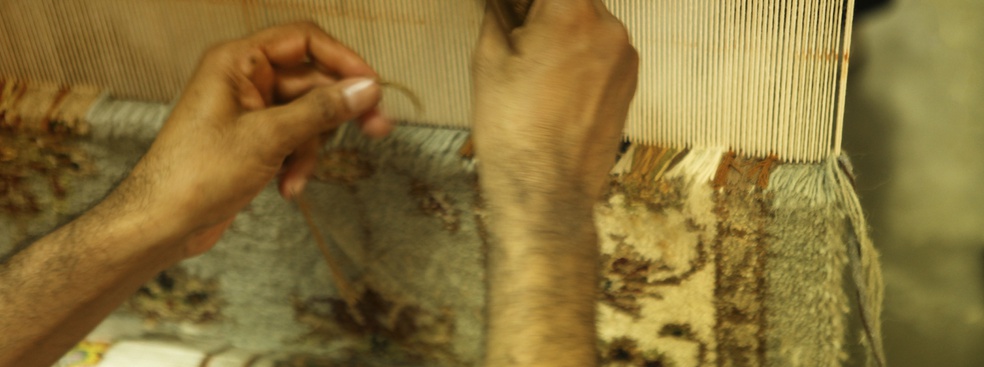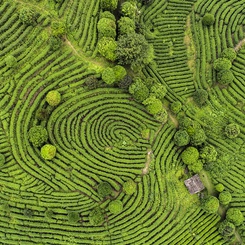When Darshan Shah launched her business of textiles in 1993, she kept her motto simple: “Use as many hands as possible”. Indeed, an important consequence of building successful luxury brands that sell hand-made products could be the creation of jobs. This proposition presents an interesting imagery: democratization of commerce at the supply side and exclusivity at the demand side. In one of the densely populated states in India with a total population of 90 million people and more than 5 million unemployed people, using as many hands as possible makes a lot of sense. Darshan works with over 1,000 weavers from West Bengal, Odisha and Bihar and employs a large number of artisans doing embroidery, tailoring, dyeing, and printing. It should be noted that since its founding, social responsibility is not an extra-curricular activity but an integral part of Weavers Studio. From this perspective, Weavers Studio is an exception not only in India but for businesses in general. There are numerous examples of businesses doing a lot of harm – think of the carbonated soft drinks industry – to society and using CSR as a tool for image make-over.
I read about Darshan Shah, the founder of Weavers Studio, in a newspaper article and got interested in this organization. Before it fell upon bad times, Bengal was famous for producing fabric that was highly sought after all over the world. However, barring a few, Bengalis have not been very successful in reviving the rich tradition of weaving and setting up successful enterprises. Fashion designers have begun to make their mark but Darshan stands out for two reasons. She started early and she is a Gujarati. Her success and commitment in Bengal piqued my interest to know more about this organization. I was also interested in the motto of Weavers Studio – use as many hands as possible – and the promise of putting that motto to use in business.
Weavers Studio Resource Centre – the non-profit organization of Weavers Studio – was set up by Darshan to share the vast collections of Weavers Studio, document them, and bring them to public domain. The resource centre had two divisions. The Textile Study Centre is a collection of textiles and books put in service of textile enthusiasts, scholars and students for research. The Weavers Studio Library brings together a collection of rare and interesting books from around the world. Workshops are held at regular intervals for exchanging views and evolving new ideas. This also helps to nurture awareness for textile design. The centre also runs charity activities: vocational training, literacy and healthcare programs, and formation of self-help groups.
In 2007, ten years after the creation of the resource centre, the non-for-profit activities were reinforced with the creation of Weavers Studio Center for the Arts with the aim to encourage a variety of artistic initiatives. It holds numerous programs to promote all kinds of arts – visual arts, cinema, theatre, photography, ceramics, sculpture, paintings, performing arts, and informal interactions – and has evolved into a space that encourages young talent.
Weavers Studio is a flexible organization that is characterized by the close interactivity between the profit and non-profit activities. According to Darshan, “this interactivity is something which is very critical, but unprofessional and not very organized.”
A sustainable strategy for profit to finance not-for-profit activities
The role of the for-profit part of Weavers Studio isto produce, sell, and export a wide range of hand-made textile products: art textiles, scarves, garments, shawls, shirts, fabrics, and saris, characterized by high quality, ethnic and original designs through retail and wholesale channels. This segment is mainly organized around two entities: Rangeen and Veda.
Rangeen is organized around four main activities: weaving, printing, dyeing, and embroidery. Master crafts persons who specialize in dyeing, block making, block printing, screen printing, and tie and dye techniques are capable of producing approximately 750 meters of cloth per day. Some orders are sourced from the villages directly. Once or twice a month, a team from Weavers Studio goes to these villages and deals with the agents. They identify original hand-made pieces and bring them to the Rangeen center where crafts persons and designers put additional creative work on them before selling them to the final customer.
Weavers Studio started to export its products in 1993 through its export arm Veda Commercial. Meticulous quality control represented a crucial part of the production process and it was all the more enhanced for exported products. Veda exports to clients in Japan, Italy, USA, UK, Australia, and South Africa to name a few. To promote their products abroad, Veda regularly participates in exhibitions and trade fairs.
The returns from these for-profit activities fund Weavers Studio’s not-for-profit activities. Whether this method is sustainable or not depends on the business acumen of the managers at Weavers Studio.
Skills through tacit knowledge – how Weavers Studio preserves the tradition
Weaving techniques are often handed down within weaving families. This knowledge transfer process has been a consequence of the caste system in India. The two essential features of the caste system are hierarchy and endogamy. Moreover, the feeling of superiority or inferiority has resulted in caste hierarchy. The desire to keep the caste structure pure is responsible for the rigid observance of endogamy – the practice of marrying within a specific ethnic group, class, or social group. Other features such as commensal taboo and occupational status can be derived from these two. The caste system provides the individual member with rules which must be observed by him or her in the matters of food, marriage, divorce, birth, initiation, and death. However, with changing times, people do not want to adhere to the occupation of their earlier generation. The craftsmen, therefore, are becoming a rare resource in the industry, with the young generation being less interested in the traditional weaves. Moreover, the pay is little compared to what they can get working in a hotel or a restaurant in a big city with the result that skilled labor is drifting away and expertise dying out. In addition, as people are becoming more educated at national and local levels, they are less willing to do printing jobs. Lots of people are also going into mills but fine cloth is only made in handlooms.
Weavers Studio’s not-for-profit activities, especially the Resource Centre, the Textile Study Centre and the Library ensure that the oraland exchange-based culture is codified, preserved, and disseminated.
To conclude, Corporate philanthropy has been a constant endeavour for many reputed business houses in India. However, the government has made it mandatory for companies above a certain size to donate money for CSR activities. From April 2014, the Ministry of Corporate Affairs in India has notified that large companies need to spend at least 2% of their average net profits for the immediately preceding three financial years on CSR activities.
This interview was first published as part of the Council on Business and Society - Council Community.









